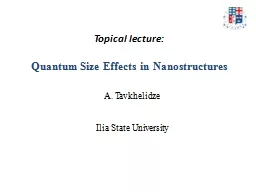

Quantum Size Effects in Nanostructures A Tavkhelidze Ilia State University Contents Quantum mechanical tunneling and applications Quantum wells and super lattices Quantum wires and quantum dots applications ID: 412026
Download Presentation The PPT/PDF document "Topical lecture:" is the property of its rightful owner. Permission is granted to download and print the materials on this web site for personal, non-commercial use only, and to display it on your personal computer provided you do not modify the materials and that you retain all copyright notices contained in the materials. By downloading content from our website, you accept the terms of this agreement.
Slide1
Topical lecture:Quantum Size Effects in Nanostructures
A. Tavkhelidze
Ilia State UniversitySlide2
ContentsQuantum mechanical tunneling and applicationsQuantum wells and super lattices
Quantum wires and quantum dots (applications)Carbon nanotubesGrapheneSlide3
Quantum mechanical tunneling
Where
hbar
is the Plank’s constant, d is barrier width,
m
is the electron mass, and
U
is the height of the potential barrier.
Slide4
Tunnel diodeSlide5
I-V characteristic of forward based tunnel diodeApplications for tunnel diodes included local oscillators for UHF television tuners, trigger circuits in oscilloscopes, high speed counter circuits, and very fast-rise time pulse generator circuits. Slide6
Josephson juction
Main applications:
SQUIDs
Millimeter wave detectors and mixers
Voltage standardsSlide7
Scanning tunneling microscope (STM)Slide8
Coulomb blockade
T<1 KSlide9
Single electron transistorSlide10
Single electron transistorSlide11
Problem 1Why samples are cooled down in the scanning tunneling microscope?Slide12
Quantum wells and super latticesSlide13
Super latticeSlide14
Quantum well applicationsSlide15
Quantum wires and dotsSlide16
Electron inside the quantum dotSlide17
Quantum dot solar cellSlide18
Problem 2Why electron wave function should equal to zero at the object boundary?Slide19
Carbon nanotubes
Armchar
Zigzag
Triple-walled armchair Slide20
Carbon nanotube propertyes
Carbon nanotubes are the strongest and stiffest materials yet discovered in terms of tensile strength and elastic modulus respectivelyStandard single-walled carbon
nanotubes can withstand a pressure up to 24GPa without deformation.All nanotubes
are expected to be very good thermal conductors along the tube, exhibiting a property known as "ballistic conduction", but good insulators laterally to the tube axis. Slide21
GrapheneCarbon carbon
bond length 0.142 nmInterplanar spacing 0335 nm
The Nobel Prize in Physics for 2010 was awarded to Andre Geim and Konstantin
Novoselov
at the University of Manchester "for groundbreaking experiments regarding the two-dimensional material
grapheneSlide22
Band structure of for arm-chair orientationSlide23
Band structure of for zig-zag orientationSlide24
Problem 3Why such hard material as graphite in your pencil easily transfers to the paper when you write? Slide25
Thank you for attention!